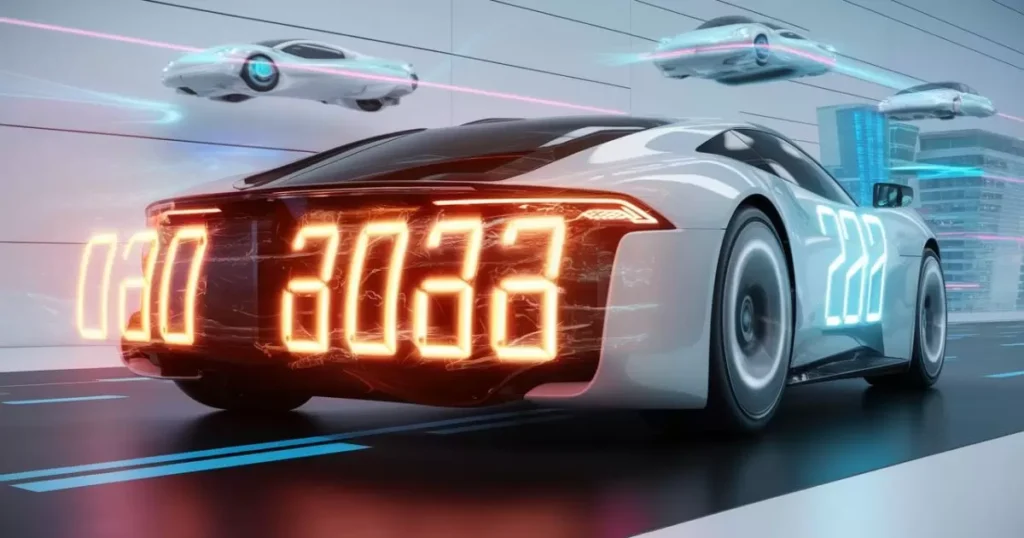Introducation
“Are digital number plates on the horizon for the UK? With evolving technology and regulatory reviews, the future of vehicle registration is poised for a high-tech upgrade.”
As technology continues to advance, the automotive industry is experiencing innovative changes that could reshape traditional practices. One such innovation is the advent of digital number plates—a modern alternative to the conventional metal or plastic registration plates we are accustomed to.
Unlike their static predecessors, digital plates utilize electronic displays to offer dynamic information and enhanced functionality. This shift promises significant benefits, including real-time updates, improved visibility, and advanced integration with vehicle systems.
However, the adoption of digital number plates also presents challenges such as higher costs, technological dependency, and regulatory hurdles.
As the UK explores the feasibility of integrating this cutting-edge technology into its vehicle registration system, the question arises: Are digital number plates coming to the UK? This article delves into the various aspects of digital number plates, their potential impact, and what the future might hold for this intriguing technological advancement.
What is a Digital Number Plate?

A digital number plate is an advanced vehicle identification system that replaces traditional metal or plastic plates with electronic displays. These plates utilize LED or e-ink technology to showcase vehicle registration numbers, which can be updated remotely. Unlike conventional plates, which are static and unchangeable, digital plates can dynamically change their content, such as displaying special messages or alerts.
Digital number plates are designed to enhance the functionality and versatility of vehicle identification. They can offer real-time updates for law enforcement, enable communication with other vehicles, and integrate with various smart technologies. This transformation from physical to digital aims to make vehicle identification more flexible and interactive.
How Do Digital Plates Compare to Traditional Number Plates?
Traditional number plates are fixed and immutable, providing a static display of a vehicle’s registration number. They are typically made of materials like metal or plastic and require physical alteration if changes are needed, such as for registration updates or personalization. The simplicity and permanence of traditional plates make them a reliable form of vehicle identification, but they lack the ability to integrate with modern technology.
In contrast, digital number plates offer a high degree of adaptability and functionality. They can update their displayed information in real-time, provide alerts for various vehicle-related issues, and potentially enhance vehicle security through integrated technology. While traditional plates are straightforward and cost-effective, digital plates introduce a new level of innovation that can significantly alter the landscape of vehicle identification.
Customising Your 3D Number Plates
Customising number plates is a common practice for vehicle owners who want to express their individuality or promote their business. Traditional customization involves choosing specific letters, numbers, or designs within regulatory limits. However, with the advent of digital number plates, customization can become more dynamic and interactive.
Digital plates can offer customization options beyond simple text alterations. For example, they might allow vehicle owners to display temporary messages, promotional content, or personalized graphics.
While 3D number plates, which use raised letters and numbers, offer a tactile and visual appeal, digital plates take customization to a new level by enabling real-time changes and more elaborate displays.
Advantages and Benefits of Digital Number Plates
Digital number plates present several advantages over their traditional counterparts. One of the primary benefits is the ability to update the displayed information remotely. This feature can enhance vehicle security by enabling instant reporting of stolen vehicles or changes in registration status.
Additionally, digital plates can integrate with smart city infrastructure to provide real-time traffic updates, toll payments, and other valuable information.
Another significant advantage is the potential for improved compliance and enforcement. Digital plates can be programmed to display messages related to vehicle compliance, such as expired tax or MOT status, reducing the need for manual checks by authorities.
Furthermore, the ability to customize and display messages dynamically adds an extra layer of functionality that traditional plates cannot offer.
Disadvantages of Digital Number Plates
Despite their advantages, digital number plates also have notable disadvantages. One of the primary concerns is the cost. Digital plates are significantly more expensive than traditional plates due to their advanced technology and the need for electronic components. This cost may be prohibitive for some vehicle owners, particularly when compared to the relatively low expense of traditional plates.
Additionally, digital plates may pose concerns related to reliability and durability. Electronic components are susceptible to damage from environmental factors such as extreme weather conditions or physical impacts.
Ensuring that digital plates remain functional and legible over time could be a challenge, potentially leading to increased maintenance or replacement costs.
Are Digital Number Plates Legal in the UK?
As of now, digital number plates are not yet fully legal for general use in the UK. The UK government and regulatory bodies are in the process of evaluating the technology and its implications for vehicle registration and road safety.
While there is interest in the potential benefits of digital plates, such as improved enforcement and dynamic information displays, extensive testing and regulatory adjustments are required before they can be widely adopted.
The introduction of digital plates would require significant changes to existing vehicle registration laws and standards. Regulatory approval would need to address concerns related to privacy, security, and the technological integration of digital plates with existing road infrastructure and law enforcement systems.
How Digital Number Plates Work: Technology and Functionality
Digital number plates utilize electronic display technologies such as LED or e-ink to present vehicle registration information. These technologies allow the plates to change their displayed content dynamically, offering real-time updates and the ability to show additional information or messages. The plates are typically connected to a network or central system, enabling remote updates and communication.
The functionality of digital plates extends beyond mere display. They can integrate with various smart technologies and infrastructure, such as traffic management systems or toll collection networks. This integration enables digital plates to provide a range of services, including automated toll payments, traffic alerts, and enhanced vehicle tracking.
Impact of Digital Number Plates on Vehicle Security
Digital number plates have the potential to significantly impact vehicle security. By enabling real-time updates and remote management, they can enhance the tracking and recovery of stolen vehicles. For example, if a vehicle is reported stolen, its digital plate can be remotely updated to reflect its status, aiding law enforcement in its recovery.
Additionally, digital plates can contribute to improved security by integrating with other vehicle technologies, such as GPS tracking and telematics systems. This integration allows for more comprehensive monitoring and protection of vehicles, potentially reducing the risk of theft and unauthorized use.
However, the reliance on electronic systems also introduces new security considerations, such as the need to protect against hacking or unauthorized access.
The Top 5 Most Memorable Movie and TV Car Number Plates
Cost and Pricing of Digital Number Plates
The cost of digital number plates is significantly higher than that of traditional plates, primarily due to the advanced technology involved. Prices for digital plates can vary depending on the features and functionality offered, but they generally represent a considerable investment. The cost includes not only the initial purchase price but also potential ongoing fees for updates and maintenance.
The higher cost of digital plates may be a barrier to widespread adoption, particularly when compared to the relatively low cost of traditional plates. However, as technology advances and production scales, it is possible that the cost of digital plates may decrease, making them more accessible to a broader range of vehicle owners.
Future Prospects: Will Digital Number Plates Become Standard?

The future of digital number plates remains uncertain, but there is considerable interest in their potential benefits. As technology continues to evolve and regulatory frameworks adapt, digital plates may become more commonplace. The advantages of real-time updates, enhanced functionality, and integration with smart infrastructure make them an appealing option for modern vehicle identification.
However, the widespread adoption of digital number plates will depend on overcoming challenges related to cost, technology reliability, and regulatory approval. If these hurdles can be addressed, digital plates may become a standard feature of vehicle registration, offering new levels of convenience and functionality for vehicle owners and authorities alike.
Answers to Key Questions
What are digital number plates?
Answer: Digital number plates, also known as electronic number plates, are high-tech license plates that use LED technology to display characters and other information. They can potentially offer features like real-time updates for registration details and dynamic information, such as emissions status.
2. When are digital number plates expected to be introduced in the UK?
Answer: As of now, digital number plates are not officially introduced in the UK. However, trials and discussions are ongoing, with the UK government and various companies exploring the feasibility and benefits of adopting this technology. The exact timeline for their widespread introduction remains uncertain.
3. What are the potential benefits of digital number plates?
Answer: Digital number plates could offer several advantages, including real-time updates of vehicle registration details, enhanced security features to prevent theft, and the ability to display dynamic information like emission status or MOT reminders. They might also improve compliance with regulations and offer better integration with smart transportation systems.
4. Are there any concerns about digital number plates?
Answer: Yes, there are concerns related to privacy and security. Digital number plates could potentially be hacked or used to track vehicle movements. Additionally, there may be issues related to the cost of implementation and the environmental impact of producing electronic components.
5. How would digital number plates affect vehicle owners?
Answer: If introduced, digital number plates could offer convenience through features like automatic updates for vehicle details and reminders. However, they might also involve higher costs for initial installation and maintenance. Vehicle owners would need to adapt to new technologies and potential regulatory changes related to digital plates.
Conclusion
Digital number plates herald a transformative shift in vehicle registration technology, offering dynamic information display, enhanced visibility, and improved vehicle security. While their advantages are significant, including real-time updates and integration with modern systems, challenges such as higher costs, technology reliability, and regulatory hurdles must be addressed.
Currently, digital plates are not yet legal in the UK, but ongoing advancements in technology and evolving regulatory frameworks suggest that their adoption may be on the horizon.
As the technology matures and becomes more cost-effective, digital number plates could become a standard feature in vehicle registration, revolutionizing how vehicles are identified and monitored. The future of digital plates in the UK will depend on a balance between technological benefits and practical implementation, making it an exciting area to watch in the coming years.

Hi! I’m Liam Scott, the creator behind DriveCarsPedia.com. I’m passionate about cars and dedicated to providing you with expert reviews, detailed guides, and the latest automotive trends. Explore my site for reliable information and insights to fuel your love for cars!








